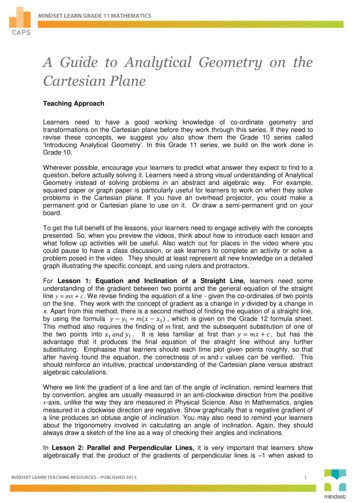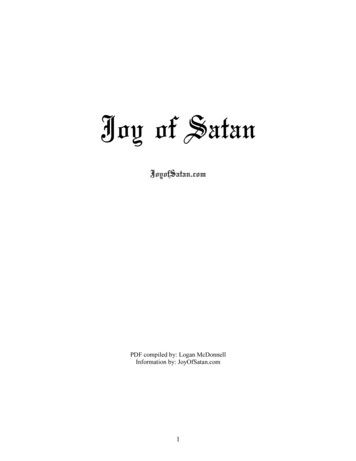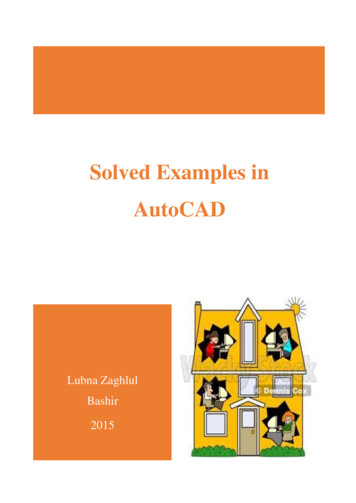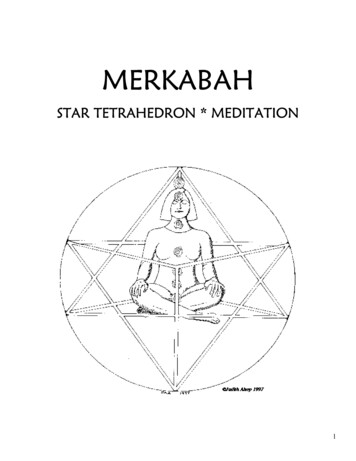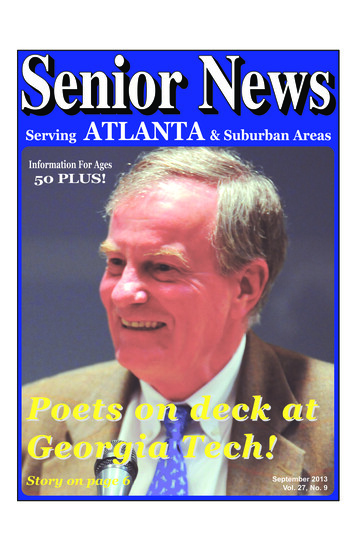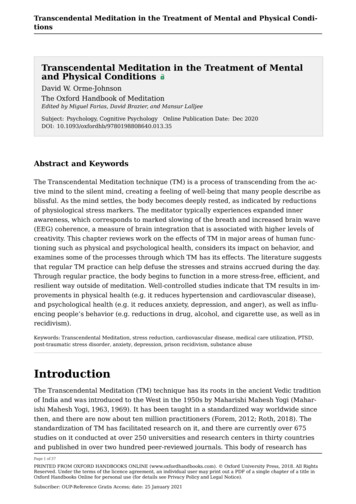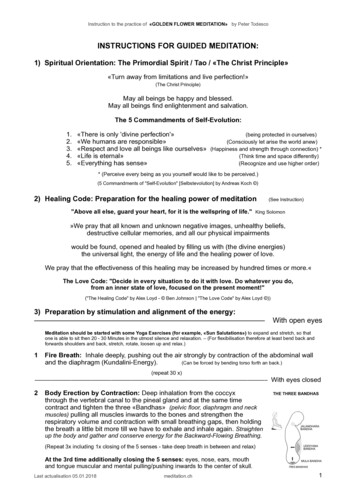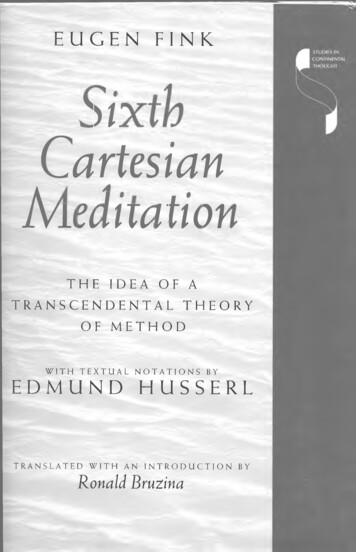
Transcription
DENTALOFW I T HTHEORYMETHODT E X T U A LN O T A T I O N SEDMUNDT R A N S L A T E DAW I T HBYHUSSERLA NI N T R O D U C T I O NRonald BrutinaBY
EUGEN FINKSixthCartesianMeditationT H E ID E A O F A T R A N S C E N D E N T A LT H E O R Y OF M E T H O DW IT H N OTATIONS BYEDMUND HUSSERLTRANSLATED W IT H AN IN T R O D U C T IO N BYRonald Bruzina" . . . a thorough critique of Husserl'stranscendental phenom enology . . .raises many new questions. . . .a classic."— J. N. M ohantyEugen Fink's Sixth Cartesian Medita tion, accom panied by E dm undHusserl's detailed and extensivenotations, is a pivotal docum entin the developm ent of one of thedom inan t philosophical directionsof the tw entieth century,Husserlian transcendental p h e nom enology. M e a n t to follow asystematic revision of Husserl'sfirst five Cartesian M editations,(continued on backflap)
SixthCartesianMeditation
Studies in Continental T h o u g h tJ o h n Sallis, general e d ito rConsulting EditorsR o b e r t B e rn a sc o n iR u d o lf BernetW i l l i a m L. M cB rideJ. N . M o h a n t yJ o h n D . C a p u toM a r y R a w lin s o nD a v id C a r rT o m R o c k m o reE d w a rd S. C a s e yH u b e r t L. D re y fu sD o n Ih d eD a v id Farrell K re llL e n o re L a n g s d o rfA lp h o n s o L in g isC a lv in O . Schragf R e in e r S ch iirm a nnC h a r le s E. ScottT h o m a s SheehanR o b e r t S oko low skiB ruce W . W ilsh ireD a v id W o o d
SixthCartesianMeditationTH EIDEAOFT R A N S C E N D E N T A LOFWITHAT H E O R YM E T H O DTEXTUALNOTATIONSBYEDM UND HUSSERLTRANSLATEDWITHANIN T R O D U C T IO NRonald BruzinaIN D IA N A U N IV E R S IT Y PRESSB L O O M IN G T O N & IN D IA N A P O L ISBY
Published in G erm an as Eugen Fink, Vi. Cartesianische Meditation.Teil 1.Die Idee Einer Transzendentalen Metbodenlebrr, edite d by Hans Ebeling, JannH o ll, and Guy van K.erckhoven.C o p y rig h t 1988 by Kluwer -Academic Publishers B.V.English-language edition 1?95 by Ronald BruzinaAll rights re servedN o part of this b o o k may be reproduced o r utilized in any form or byany means, electronic or mechanical, including photocopying andrecording, or by any information storage and retrieval system, withoutpermission in w ritin g from the publisher The Association of AmericanUniversity Presses' Resolution on Permissions constitutes the onlyexception to this prohibition.The paper used in this publication meets the m inim um requirements of AmericanNational Standard for Information Sciences— Permanence of Paper for PrintedLibrary Materials, A N SI Z 39.48 -1984. T“M anufactured in the U nited States of AmericaLibrary o f Congress Cataloging-in-Publication DataFink, Eugen.[Idee einer transzendentaler Methodenlehre. English]Sixth Cartesian meditation : the idea o f a transcendental theoryof m ethod / Eugen F in k ; with the complete textual notations byEdm und Husserl , translated with an introduction by Ronald Bruzina.p.cm. — (Studies in Continental thought)T ranslation of: VI. cartesianische Meditation. T. I.Includes bibliographical references and index.ISBN 0-253-32273-1 (alk. paper)1. Husserl, E dm und, 1859-1938 Cartesianische Meditationen.2. P henom enology.III.I. Husserl, Edmund, 1859-1938.Title: 6th Cartesian meditation.transcendental theory of m ethod.B3279.H94F4913V. Series.1995193— dc2094-341 2L.II. Title.IV. Title: Idea of a345 00 9 998 9796 95
ContentsT RA N SLA T O R'S IN T R O D U C T IO N[DRAFT O F A F O R E W O R D ]PREFATORY N O T E [TO T H E H A B I T A T I O N TEXT], DECEM BER, 1945v ii12S IX T H [CA RTESIAN ] M E D IT A T IO NTh e Idea o f a T ranscendental T heory of M e th o d§1.T he m e th o d o lo g ic a l lim ita tio n of the previous M e d ita tio n s3§2.T he them e of the transcendental theory of m e th o d10§3.T he "self-reference" of p h e n o m e n o lo g y13§4.T he p roblem and articulation o f the transcendental theoryof m e th o d19§5.P h e n o m e n o lo g iz in g as the action of reduction29§6.P h e n o m e n o lo g iz in g as a process of regressive analysis48§7.P h e n o m e n o lo g iz in g in "constructive" p h e n o m e n o lo g y54§8.P h e n o m e n o lo g iz in g as theoretical experience66§9.P h e n o m e n o lo g iz in g as an action o f ideation77§10.P h e n o m e n o lo g iz in g as predication§11.P h e n o m e n o lo g iz in g as "m aking in to a science"§12.84100A) The problem of the scientificity of phenomenologizing101B) The enworlding of phenomenologizing106C) The concept of "science"133"P henom enology" as transcendental idealism152
A P P E N D IC E STexts b y E d m u n d Husserl relating to Eugen Fink'sD ra ft o f a S ix th M e d ita tio nA.B.C.A p p e n d e d pages a n d insertions [from Summer 1933 to Ja n u a ry 1934)163A p p e n d ix I163A p p e n d ix II163A p p e n d ix III165A p p e n d ix IV165A p p endix V166A p p endix V I167A p p endix V II168A p p e n d ix V III170A p p e n d ix IX171C o m m e n ts a n d research notes174A p p e n d ix X174A p p e n d ix X I178A p p e n d ix X II181U nassigned pages188A p p e n d ix X III188A p p e n d ix X IV190A p p endix X V191T R A N SLA T O R'S N O T E S193IN D E X201
T R A N SLA T O R 'SIN T R O D U C T IO NEugen Fink's "Sixth Cartesian M e d ita tio n " is one of those famous u n k n o w nworks in p h ilo so p h y that ha u n t the margins of established texts w hile seldomif ever c o m in g to lig h t themselves, at least in any form other than scant frag ments. O ccasio nally, however, one of these m issing writings does becom e ac cessible in full and is at last itself know n, and this is the case w ith the presentpublication. For a w ho le generation of philosophers in p h e n o m e n o lo g y —w hich is a lo n g tim e in the m odern age of rapid and extensive co m m u n ica tio nand scholarship— the Sixth M e d ita tio n was a w ork k n o w n to have been w rit ten, yet one that very few had ever seen, one that c o u ld easily be presumednot to have survived the descent of fascism and war u p o n Europe. T hose w h ohad read the Sixth M e d ita tio n were individuals w h o h a d m ain tained a closeconnection w ith E dm u n d Husserl even as the times darkened after 1933, andas ackno w ledgm ent o f Husserl's accom plishm ents and of his very nam e cameto be suppressed in G erm any. Published m e n tio n o f the Sixth M e d ita tio n firstoccurred in 1941 in France, in G aston Berger's Le cogito dans la philosophic deHusserl1 to be fo llow ed o n ly after the e n d o f the war b y reference to it in M a u rice Merleau-Ponty's Phenomenologie de la perception.2It was m ost natural, then, that, w hen the e d itin g of Husserl's CartesianM ed itations was under w ay for the first volum e of the Husserliana edition, in terest w o u ld again turn to this text of Fink's. S tephan Strasser spoke of it inhis editor's in tro duction to the Cartesianische Meditationen,3 expressing the hop ethat, w hile the Sixth M e d ita tio n d id not figure in to the editio n he was prepar ing, it w o u ld nevertheless be itself published as part o f the w ho le set o f revi sion texts that Fink h ad produced for Husserl for the Cartesian M e d itationsin that earlier decade. T he texts in question— the Sixth M e d ita tio n itself andthese revision texts for Husserl's earlier five Cartesian M e d ita tio n s— were andare not, however, part o f the Husserl Nachlass in the Archives in Louvain.4
A part from the p eriod w hen Fink resided and lectured at Louvain (from thespring o f 1939 to the autum n of 1940),5 these texts were n o t available eventhere,- and n o t until1971 were copies finally prov ide d for the HusserlArchives. Arrangem ents for their p u b lica tio n g o t under w ay o n ly after Fink'sdeath in 1975 a n d after the o p e n in g of the adjunct series, H usserliana Dokum ente, in 1977. It is in this series, now , that the texts have finally appeared ina two-volume editio n, Eugen Fink, V I. Cartesianische Meditation, Part I: Die Ideeeiner Transzendentalen Metbodenlebre, ed. H ans Ebeling, Ja nn H o ll, and G u y vanKerckhoven,- Part II: Ertjanzungsband, ed. G u y van K erckhoven.6 It is the textof the first of these tw o volum es that is integrally translated here.T he question of h o w and w h y these texts were preserved and yet kept p ri vate is directly b o u n d up w ith the history of their origin, w h ich includes n a t urally the nature of their content. T h ey are the p ro d uc t of an intim atecollaborative effort on the part of tw o philosophers, one an established andw orld-renow ned master, the other a y o u th fu l scholar w h o had just finishedhis doctoral work. Each had an in dep ende nt m ind, each h ig h ly valued theother's work, and b o th were deeply involved in a shared project of p h ilo sophic investigation and reflection. Y et they were different individuals in thisc o m m o n project,- and so the project acquired from the one differing emphasesand a differing character than it d id from the other. Both were beginners, butdifferently: one was a beginner in the final stage of a life lo n g th in k in g ,7 theother a beginner in the first realization of w h a t w o u ld be a sim ilar dedication.It w ill not be possible in this in tro d u c tio n to treat in any great detail the id e n tities and differences between these tw o link ed endeavors,- and yet som eth ingof this w ill have to be covered, for the nature of the docum ents given here inEnglish is such that the p rim a iy th in g is precisely the interplay of the twothinkings. W h e n one considers w h a t this final period of Husserl's th in k in g istaken to represent, nam ely, the cu lm in a tio n of an originally Cartesian im p e tus that is b e ing at the same tim e transcended, then the d ocu m en ted recordof the direct interplay, the dialogue, of these tw o m inds deep w ith in tran scendental p h e n o m e n o lo g y takes on special im portance.W h e n we lo o k at the title of the m ain text of the present translated v o l ume, we should notice tw o things. First, we have here the sixth o f a series of"Cartesian" meditations,- second, the subtitle of this sixth "Cartesian" m e d ita tion, "The Idea o f a T ranscendental T heory of M e th o d /' is frankly K antian.W e must understand, then, w h a t the fuller context and principal orientationof this piece are in order to interpret it properly.In the first place, it m ust be recognized that Fink's Sixth M e d ita tio n wasm eant to fo llow n o t u p o n Husserl's Cartesian M ed itatio ns as they have b e com e fam iliar to us up u n til n o w ,8 bu t u p o n an extensively reworked version
that was produced three years after Husserl's first full revision in 1929. Finkhim self described this new context in 1946 in a letter to H . L. V an Breda, thenin the m idst of p la n n in g the first p u blication o f materials from the Nachlass,namely, the G erm an text o f Husserl's Cartesian M ed itations. Fink writes:T h e g la d news a b o u t the w o rk o f the H usserl A rchives a n d its fo rth c o m in gp u b lic a tio n s is m o st w e lc o m e . A b o v e all th e e d itin g o f the G e rm a n text o f theM é d ita tio n s C artésiennes is u rg e n tly needed. As y o u perhaps k n o w , H usserlwas n o t ready to p u b lis h th e G e rm a n text, because he saw m a jo r s h o rtc o m ings in its presentation. In th e years 1932-33, w h e n H usserl was p re o c c u p ie dw ith the idea o f this pro je ct, p r o d u c in g a G e r m a n e d itio n , I h a d to draft forh im a rew o rkin g o f the C arte sian M e d ita tio n s .Fink goes on to describe briefly his revision texts (all o f w h ic h are now in theErgcinzuncjsband), and then goes on to say:A fte r the appearance o f the G e rm a n text, I shall perhaps p u b lis h these re v i sion proposals o f m in e for th e C artesian M e d ita tio n s , proposals th a t H usserlh a d accepted. . . . As a c o m p le m e n t to th e L o u v a in e d itio n o f the M e d ita tio n sthis m a y have a certain h isto rical sig nificance, for it show s those p o in ts o nw h ic h H usserl was o p e n to a re sh a p in g o f his text. H usserl h a d a d o p te d m yproposals so fu lly that, at the tim e , he pro p o se d to m e th a t m y revisions o f histext a n d m y entirely new "S ix th M e d ita tio n " (o n th e idea o f a transcendentalth e o ry o f m e th o d ) be in c lu d e d in the p la n n e d G e r m a n e d itio n a n d p u b lish e du n d e r jo in t a u th o rs h ip . P o litic a l d eve lo pm e n ts after 1933 m ad e it im po ssibleto p ro ce e d w ith this p la n .9W h a t we shall be prim arily interested in is the substance of the revisions Finkh a d drafted for Husserl, in c lu d in g their cu lm in a tio n in the new Sixth M e d i tation, and the im plications they h eld for Husserl's further w ork in this finalperiod of his life,- for w h a t comes clear in them is that they contribute p o si tively and directly to the displacem ent of a Cartesian-based exposition of p h e no m eno lo gy. T o understand w hat these revisions represent, however, wehave to k n o w more b o th abou t the place Fink h ad in the enterprise o f th in k ing that em braced b o th Husserl and h im , and as well about the resources andconcerns that Fink him self b ro u g h t to his w ork in that enterprise. W e shalltherefore first review in some detail the history of the revision w ork on theCartesian M ed itatio ns as it involved b o th Husserl and Fink, and then lookm ore closely at the special role Fink played in Husserl's w ork and th in k in gduring this final period. T h a t done, we shall be able to focus on the textsthemselves. In the course of lo o k in g at the texts it w ill becom e clear w hat spe cial p h ilo so p h ic resources Fink was c o n trib u tin g to the re th in k in g of tran
scendental p h e n o m e n o lo g y th a t is so p ro m in e n t in Husserl's final efforts andthat has so strongly m arked p h e n o m e n o lo g ic a l w o rk since.I. Husserl's Cartesian M editations and their revision10M u c h is fam iliar re gardin g Husserl's preparation o f an in tro duction to p h e n o m e n o lo g y u nder the title "Cartesian M e d ita tio n s." T he occasion was a jo in tin vitatio n from the In stitut d'Études germ aniques and the Société française deP h ilosop hie to give a set of lectures on the "Intro du c tio n to TranscendentalP h e n o m e n o lo g y ."11 Husserl gave his lectures in tw o presentations of tw o eachon February 23 and 25, 1929, appropriately in the A m p h ith éâtre Descartes inthe Sorbonne. T he success o f his lecturing in France, w h ich in clu ded four e m inently successful days in Strasbourg, led to an arrangem ent for translatinginto French a n d the n p u b lis h in g a m ore fully w o rk ed out version o f his C arte sian Meditations,- thus, u p o n his return to Freiburg (M arch 12), Husserl set tow ork u p on a revision of his Paris lectures. T his revision took from the m iddleof M arch u n til the m id d le o f M a y , and resulted in the text that has since b e com e fam iliar u nder th a t title. W it h the revision don e and the text sent off tothe translators in Strasbourg, Husserl felt the revision could also be publishedin G erm an before the e n d o f the year.12W ith in a few short m o n th s , how ever, Husserl was confronted w ith reasonto th in k that the C artesian M e d ita tio n s as the y th e n were w o u ld n o t do as anadequate statem ent of his p h e n o m e n o lo g y , especially for a G erm an audience.T he cause for this was q u ite sim p ly ---- H eidegger. T he m o nths from S ep tem ber 1928 to the sum m er of 1929 had been a tim e of feverish activity forHusserl, in v o lv in g intense p ro d u c tiv ity .13 O n c e the first revision of the C a rte sian M e d ita tio n s was finish ed , Husserl h a d to correct the proofs for his For male und Transzendentale Logik (to appear that year in his Jahrbuch, V ol. X),- he hadw ritten that masterful text from N o v e m b e r 1928 to January 1929, in the threem o n th s prior to b e g in n in g w o rk on the lectures for Paris. A n d other thingswere h app e ning . In the sp ring o f 1929 Husserl h a d received the first part ofG e o rg M isch's b o o k Lebensphilosophie und Phänomenologie, w hich was appearing inserial form in the jo u rn a l Philosophischer Anzeiger.'4 M is c h had dedicated thisw ork to Husserl "on his 7 0 th b irth d a y ," w h ic h H usserl h a d celebrated on A pril8. In a letter w ritten to M is c h on June 27, 1929, Husserl explained that d e spite the press of o th er w o rk he h a d fo un d som e tim e to read M isch's essay,a nd h a d don e so w ith great in terest.15 A lth o u g h Husserl was to give Misch'sw ork a really close re ad in g o n ly a year later, nevertheless this p u blicly a p pearing treatm ent o f H e id e g g e r as the representative o f p h e n o m e n o lo g y most
com patible w ith the th o u g h t of W ilh e lm D ilth e y now p ro m p te d Husserl toundertake a m uch m ore serious study of Heidegger's w ork than he h a d thusfar made. O n c e the proofreading o f Formal and Transcendental Logic was finished(July l), Husserl therefore turned to a careful reading o f Being and Time and Kantand the Problem of Metaphysics.'6 N o d o u b t Husserl fo un d the need for this studyreinforced b y w hat he heard w hen H eideg ger gave his official inaugural lec ture, "Was ist M etaphysik?" (July 24). It must have clearly show n Husserl thevast differences between his ow n and Heidegger's c oncep tion o f h o w p h ilo s o p h y was to be done and w hat its m ain themes were.The result of Husserl's long-overdue close study of Heidegger's th o u g h twas that, barely a year after H eideg ger arrived in Freiburg as Husserl's suc cessor, and o n ly a few m o nth s after Heidegger's last expression of praise forh im at the celebration of his seventieth birthday, Husserl came to the c o n clusion, as he expressed it to R om an Ingarden in a letter w ritten tow ard theend of 1929, that "I can not include [his] w ork w ith in the fram ework of m yphenom enology, . . . that I must reject it entirely as to its m e th o d and in theessentials of its c o n te n t."17 T h at this was a sudden and harsh realization is in dicated in the fact that im m ediately before this study of H eidegger, in ch eck in g the proofs for his Formale und Transzendentale Logik, Husserl had left intact areference to the c o m in g p u blication ("in autum n” he even says!) of the C a rte sian M editations in their then existing fo rm .18 U n d e r the im pact o f his new lygained awareness, however, he c o u ld no longer deem these M e d itations tobe adequate.A t first Husserl th o u g h t that, in order to explain the character of his p h e nom enology in the context of the ascendant H eideggerian enterprise, hem ig h t add an additional, leng th y in tro duc tio n to w h a t was then to be his nextbook, the Cartesian M editations, w hich, as already revised, were virtuallyready for p u b lic a tio n .19 But in the course of w o rk ing out the topics and pointsthat w ould be needed for the explanation he envisioned, he was soon led tothe conviction that more than an "introduction" was needed: the CartesianM editations had to be given a new, m ore extensive revision. In D ecem ber ofthat year, 1929, he indicated to Ingarden that a wholesale rew orking of hisCartesian M ed itatio ns in to a fuller systematic treatm ent of his p h e n o m e n o l ogy was under way, to be ready, he hop ed, b y the end of the next year.20W o rk on this new, larger-scale revision of the M ed itations, however, h adto face interruptions by other tasks and obligations. For example, Husserl h a dto go over the m anuscript w ork that L udw ig Landgrebe was d o in g to preparew hat w o uld becom e Erjahrung und Urteil. T h at was g o in g to take time. O nM arch 19, 1930, Husserl w rote to Ingarden that he c o u ld n o t really afford justthen to give it that time:
Translator's IntroductionxiiI saw th a t I w o u ld still n e ed 4-6 m o n th s o f w o rk, a n d 1 s im p ly must not p o s t p o n e the G e r m a n e d itio n o f the C arte sian M e d ita tio n s th a t lo n g . For this w illbe the m a in w o rk o f m y life, an o u tlin e o f th e p h ilo s o p h y th a t has c o m e tofru itio n for m e, a fu n d a m e n ta l w o rk o n m e th o d s a n d o n the p ro b le m a tic ofp h ilo s o p h y . A t least for me [it w ill be] the c o n c lu s io n a n d final cla rity w hosecause I can c h a m p io n , w ith w h ic h 1 can die in peace. (But w h a t is m ore im p o rta n t is th a t I feel c a lled u p o n to in tervene d ecisively in this w a y in th e c rit ical s itu a tio n in w h ic h G e rm a n p h ilo s o p h y n o w stands.) T h e little French text,a p p e a rin g at Easter (a b o u t 100 pages) w ill not be a mere tra n sla tion o f th e G e r m an , because for th e G e r m a n p u b lic — in its present situatio n (th e faddishs w in g to a p h ilo s o p h y o f "existence," the a b a n d o n m e n t o f "p h ilo s o p h y as rig orous science")— w h a t is n e e d e d is a m o re extensive e x p o s itio n a n d furthere lab o ra tio n rig h t u p to the h ig h e st "m etaphy sical" p ro b le m a tic . I'm w o rk in gfull o f v ig o r a n d w ith extrem e c o n c e n tra tio n , [but] I w o n 't be fin is h e d w iththe b o o k before a u tu m n .31T h e m o tiv atio n for Husserl's w ork on an elaboration of the Cartesian M e d i tations b e y o n d the form o f their first revision— and the form in w h ic h alonethey are still k n o w n — was clearly the need he saw for a statem ent of his p h e no m e n o lo g y that w o uld explain and assert itself in the then-current p h ilo sophical clim ate in G e rm any . H e saw p h e n o m e n o lo g y b e ing rapidly eclipsedby other m ovem ents w h ic h n o t o n ly subverted the principles for w h ic h p h e no m e n o lo g y stood bu t also, in his eyes, grossly misrepresented w h a t p h e no m e n o lo g y was really about. H e h a d to react, h o p in g to be listened to.( Little d id he k n o w that he had bu t three m ore years in w h ich his voice w o uldeven be p erm itted to be heard.) W h a t h a pp e ned now , as the year 1930proceeded, can o n ly be understood in terms of this driving m o tiv atio n onHusserl's part to represent his p h e n o m e n o lo g y in an effective, com p re h e n sive statement.In the spring, or at the latest the early summer, o f 1930 Husserl finallyturned to a fuller reading of M isch's treatm ent of life-philosophy and p h e n o m eno lo gy , Lebensphilosophie und Phänomenologie. By no w Husserl had the sec on d installm ent as well as the first, w h ich in their serialization carried thesubtitle "A D ebate w ith Heidegger",-22 and w h a t Husserl no w read caused h imto change his plans m ore radically. For M isch's treatm ent show ed that them isunderstanding and critique of Husserl's p h e n o m e n o lo g y w ent b ey o ndw hat H eidegger said o f it. In treating D ilthey's p h ilo so p h y of life as standingin stark contrast to Husserl's p h ilo so p h y , M is ch touched u p on matters at thecore of Husserl's th in k in g . M is c h em phasize d in D ilthey's program the them eof liv ing historical m o vem ent in hu m an existence and th o u g h t, as againstw hat he took to be the strongly logic-centered intellectualism o f Husserl's
Translator's Introductionxiiiworks.23 Equally distressing on top of this was surely M isch's lin k in g of H e i degger's analysis of "Dasein" w ith this positive feature of D ilthey's positionand therefore the ascription to Heidegger's w ork of a value b eyo nd Husserl's.It was a far broader ap ologia that Husserl had to provide, if his p h ilo so p h ywas to be properly understood, one that w o u ld show his th in k in g to be atgrips precisely w ith w h a t was m ost deeply and fundam entally concrete andoriginative in hu m an life. For this, som eth ing m ore than the Cartesian M e d i tations was needed.N o r was it enough sim ply to produce individual studies of aspects of h u m an beings as they were treated in Husserl's transcendental p h e n o m e n o l og y.24 W h a t was needed was a framework, a com prehensive plan in terms ofw h ich one cou ld systematically link the highest principles of p h e n o m e n o logical m e th o d and ex planation w ith the m ost m anifest and preo ccupy ing fea tures o f real existence, so that one cou ld show clearly and rigorously h o w thelatter were given their true and full m e aning in terms of the former. T hus wasconceived the m o num e ntal project of the "System of P henom enolog ical P h i losophy," in to w h ich Husserl now threw his efforts. A n d w ith this we beginto see the place o f Eugen Fink in the e cono m y of Husserl's final period ofproductivity.T he Ergdnzungsband, w h ic h as Part 2 accom panies the volum e in w h ic h thetexts here translated are published, opens w ith the plan for this new workthat Fink prepared for Husserl that very summer, the "Layout for E dm u n dHusserl's 'System of P henom enolog ical P h ilo s o p h y .'"25 D a te d A ugust 13,1930, it was ready for Husserl to take w ith h im on a lo n g w o rk ing h o lid a yp lan ned for C hiavari, on the eastern half of the Italian Riviera, where he in deed studied and annotated it.26 It is a remarkable docum ent, b o th for itsscope and in its detail, especially if one compares it to the m u c h briefersketch of Husserl's ow n for the same System .27 Both the agreements and thedifferences between the tw o conceptions m erit study,- bu t for that a more ex tensive treatm ent w o uld be needed to make clear h o w each, Husserl andFink, w o u ld actually w ork out the plans thus envisioned. A n d here is wherethe tw o volum es o f the VI. Cartesianische Meditation take on their value,- for ina d d itio n to the fact that they contain im p o rtan t com ponents of Fink's w o rk in g out of the plan for a new, full systematic statem ent of transcendentalp h e n o m e n o lo g y , the inclusion in b o th volum es o f all o f Husserl's marginalnotations, additions, and m odifications to the drafts in question enables us tosee in the very same text som eth ing of the w ay Husserl agrees w ith or differsfrom Fink's conception.For example, one signal difference is that the w h o le first section of the firstb o o k in Fink's "Layout," entitled " O n the B eg inning and the Principle of P h i
Translator's IntroductionXIVlosophy,"28 is no t given in Husserl's outline. W h a t is im po rtan t about this sec tion is that it gives a place o f prom inence to the topic "world"— specifically,the pregivenness of the w o rld relative to any in cip ie n t p h ilosop h ical reflec tio n — as the issue by w h ich p h e n o m e n o lo g y opens, and to w h ic h it remainsb o u n d , in the w h o le idea o f reduction. Furthermore, it is this very section, andit alone of his w ho le plan, w h ic h Fink w orked ou t in full typescript form in D e cem ber 1930 and January 1931. T his is the second text p u blish ed in theErgdnzungsband, "D raft for the o p e n in g section o f an Intro duction to P h e n o m eno lo gy ,"29 where one sees as well the num erous notations Husserl m ade toit— he h a d read it closely. T his is som ething, again, that we shall return to later.Fink produced this 120-page typescript after his and Husserl's return fromC hiavari on N o v em b er 4, 1930. T he sojourn in C hiavari h a d been a disasterfor Husserl; before the first m o n th was out, he h a d contracted a serious caseof bronchitis and was virtually incapacitated for the rest of his stay. Fink hadto w ork for the m ost part m ore or less alone, on their jo in t projects as well ason his ow n research tasks.30 But on their return, Husserl again threw him selfin to his work. H e h a d no w pretty well ado p te d the overall plan o f Fink's "Lay out." In the m iddle o f the weeks du rin g w h ic h Fink was at w ork on his ty pe script, Husserl show ed his altogether positive disposition tow ard Fink's planin a letter to Ingarden w ritten D ecem ber 21. In g iv in g a brief description of"the systematic w ork on fundam entals in p h e n o m e n o lo g y " w h ic h he nowm eant to produce, Husserl follow s this very co nc e p tio n that Fink h a d p ro v ided him,- and after it he adds, "m y m ost talented Fink is the v ig ila n t helperin this, w ith o u t h im I w o u ld be lost."31 (W e shall return later to this k in d oftestim ony on Husserl's part regarding Fink's role in the w ork o f this period.)From the spring o f 1930 to the spring of 1931 Husserl p rod uced a rich va riety o f Forscbungsmanuskripten on topics such as the w o rld of hu m an life andh isto ry ,32 the "flow ing live present" as h avin g ultim ate constitutive fu n c tio n ,33and the problem o f intersubjectivity, w h ich , in contrast to the treatm ent inhis Cartesian M ed itations, was analyzed here as having a p rim ord iality w iththe reflecting m o nadic "I."34 O n e context for these studies was, o f course, thep h ilo so p h ic situation that turned Husserl to the idea of the new c o m p re h e n sive systematic presentation o f phenomenology,- bu t this was not the o n ly taskthat he a n d Fink were lab o rin g over. A n o th e r im p o rtan t project, to w h ic h wehave here given no m e n tio n yet, was to b rin g Husserl's 1917-1918 Bernautime-consciousness studies to coherent and in telligib le form, a task w h ichHusserl had given entirely over to Fink, even w hile he, Husserl, was p ro d u c in g new materials on the question of tem porality.T he extent o f the w ork w h ic h the "System o f P henom enolog ical P h iloso phy" alone w o u ld dem and, however, was b e g in n in g to w eigh heavily. O n
sion texts that Fink had produced for Husserl for the Cartesian Meditations in that earlier decade. The texts in question— the Sixth Meditation itself and these revision texts for Husserl's earlier five
